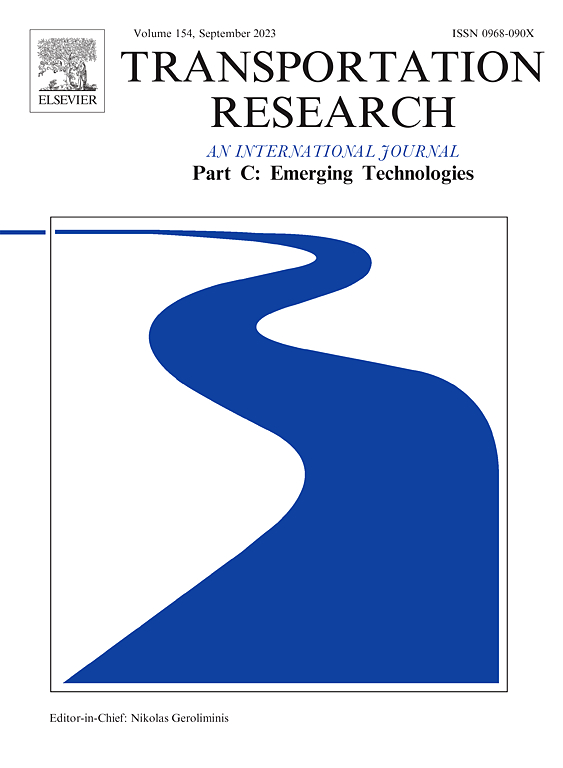Efficient pedestrian and bicycle traffic flow estimation combining mobile-sourced data with route choice prediction
IF 7.6
1区 工程技术
Q1 TRANSPORTATION SCIENCE & TECHNOLOGY
Transportation Research Part C-Emerging Technologies
Pub Date : 2025-02-18
DOI:10.1016/j.trc.2025.105046
引用次数: 0
Abstract
Accurate estimates of traffic flow measures like annual average daily traffic (AADT) are crucial for roadway planning, safety, maintenance, and operation. Due to resource constraints and high costs of traditional monitoring methods, we develop a methodology to estimate pedestrian and bicyclist traffic flows using mobile data sources, avoiding privacy issues of household surveys. The methodology is general, and potentially could be used with any reasonably comprehensive mobile source data set. To deal with erroneous and high variability data from mobile data sources we use different techniques to estimate and keep improving an origin–destination (OD) matrix constructed using the observed link flows to ultimately obtain reasonable approximations of actual link flows. We provide a non-linear optimization formulation along with a projected gradient descent based solution algorithm to solve this problem. Furthermore, we present the performance of the solution algorithm for several networks including the Twin Cities’ bicycle and pedestrian networks. We also compare the accuracy of our estimate with manually collected AADB and AADP counts from Minnesota Department of Transportation monitoring stations. For the Sioux-Falls network, the highest error from our model was less than 1%. These estimates can be improved by using existing methods to improve the quality of mobile sourced data as a pre-processing step to our method.
结合移动源数据和路径选择预测的高效行人和自行车交通流量估计
准确估计年平均日交通量(AADT)等交通流量指标对道路规划、安全、维护和运营至关重要。由于资源限制和传统监测方法的高成本,我们开发了一种使用移动数据源估计行人和自行车交通流量的方法,避免了家庭调查的隐私问题。该方法是通用的,并且可能用于任何相当全面的移动源数据集。为了处理来自移动数据源的错误和高可变性数据,我们使用不同的技术来估计和不断改进使用观察到的链路流构建的起点-目的地(OD)矩阵,最终获得实际链路流的合理近似。我们提供了一个非线性优化公式以及基于投影梯度下降的求解算法来解决这个问题。此外,我们还展示了该算法在包括双子城的自行车和行人网络在内的几个网络中的性能。我们还比较了我们估计的准确性与手工收集的AADB和AADP计数从明尼苏达州交通部监测站。对于苏-福尔斯网络,我们模型的最高误差小于1%。这些估计可以通过使用现有的方法来提高移动源数据的质量,作为我们方法的预处理步骤来改进。
本文章由计算机程序翻译,如有差异,请以英文原文为准。
求助全文
约1分钟内获得全文
求助全文
来源期刊
CiteScore
15.80
自引率
12.00%
发文量
332
审稿时长
64 days
期刊介绍:
Transportation Research: Part C (TR_C) is dedicated to showcasing high-quality, scholarly research that delves into the development, applications, and implications of transportation systems and emerging technologies. Our focus lies not solely on individual technologies, but rather on their broader implications for the planning, design, operation, control, maintenance, and rehabilitation of transportation systems, services, and components. In essence, the intellectual core of the journal revolves around the transportation aspect rather than the technology itself. We actively encourage the integration of quantitative methods from diverse fields such as operations research, control systems, complex networks, computer science, and artificial intelligence. Join us in exploring the intersection of transportation systems and emerging technologies to drive innovation and progress in the field.

 求助内容:
求助内容: 应助结果提醒方式:
应助结果提醒方式:


